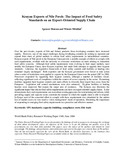| dc.description.abstract | Over the past decade, exports of fish and fisher
y products from developing countries have increased
rapidly. However, one of the major challenges fa
cing developing countries in seeking to maintain and
expand their share of global markets is stricter f
ood safety requirements in industrialized countries.
Kenyan exports of Nile perch to the European Union
provide a notable example of efforts to comply with
such requirements, overlaid with the necessity to ov
ercome restrictions on trade relating to immediate
food safety concerns. Although food safety requirement
s were evolving in their major markets, most
notably the European Union, most Kenyan exporte
rs had made little attempts to upgrade their hygiene
standards. Likewise, the legislative framework of
food safety controls and facilities at landing sites
remained largely unchanged. Both exporters and th
e Kenyan government were forced to take action
when a series of restrictions were
applied to exports by the European Union over the period 1997 to 2000.
Processors responded by upgrading their hygiene c
ontrols, although a number of facilities closed,
reflecting significant costs of compliance within the c
ontext of excess capacity in the sector. Remaining
facilities upgraded their hygiene controls and made e
fforts to diversify their export base away from the
European. Legislation and control mechanisms we
re also enhanced. Hygiene facilities at landing
beaches were improved, but remain the major area of weakness.
The Kenyan case illustrates the
significant impact that stricter food safety requirements
can have on export-oriented supply chains. It also
demonstrates how such requirements can exacerbate existing pressures for restructuring and reform, while
prevailing supply and capacity issues constrain the manner
in which the supply chain is able to respond.
In Kenya most of the concerted effort to comply
with these requirements was stimulated by the sudden
loss of market access in very much a ‘crisis manage
ment’ mode of operation,
illustrating the importance
of responding to emerging food safety requireme
nts in a proactive and effective manner. | en |

